No matter how much we plan, sometimes in life there are things that happen suddenly, some of which that are totally outside of our control. If these changes impact your hotel, whether positively or negatively, the key is effective, fast communication to make sure guests (and potential customers) are aware of the situation.
The first port of call should probably be your hotel website. It’s the ideal place to communicate urgent and important messages that are directly relevant to the guest, whether it be information about weather updates or hotel refurbishments. Theoretically this is a simple practice, however, not all hotel marketers have access to make on-the-fly changes to their website, without help from their tech team. Using a website personalization tool is the perfect way to give hotel marketers the flexibility they need to be able to publish pressing messages within minutes.
See below six examples of how hoteliers published effective, timely messages on their website to reassure and engage website users when it mattered most.
Sudden market changes
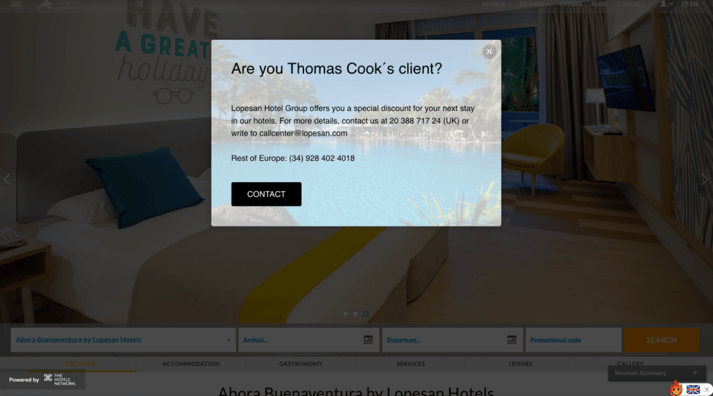 Layer with an offer to attract guests stranded by Thomas Cook issues
Layer with an offer to attract guests stranded by Thomas Cook issues
With the recent shock announcement of international travel agent Thomas Cook closing its doors, there have been several cases of hotels declining bookings made through Thomas Cook and even kicking out customers who have prepaid on the site. That is why the Abora Buenaventura Hotel (Part of the Lopsean group) have seized the opportunity and aggressively marketed their rooms to guests that have been affected by the Thomas Cook closure. As you can see in the picture above, Abora Buenaventura have employed a welcome layer so as to immediately draw in the attention of potential bookers, maximising engagement and direct booking from desperate holiday planners.
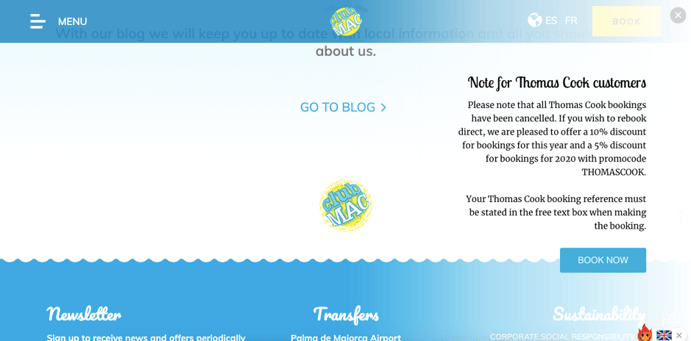 Layer giving an update to clients who booked at the hotel through Thomas Cook
Layer giving an update to clients who booked at the hotel through Thomas Cook
Club Mac have introduced a similar layer informing all Thomas cook clients that their bookings have been cancelled, but instead of losing all of those customers, they have offered them the opportunity to re-book for discounted rates. This will certainly help boost engagement and conversion rates as many of Thomas Cook’s customers will be scanning the web trying to find out if they are affected by the closure.
Extreme weather warnings
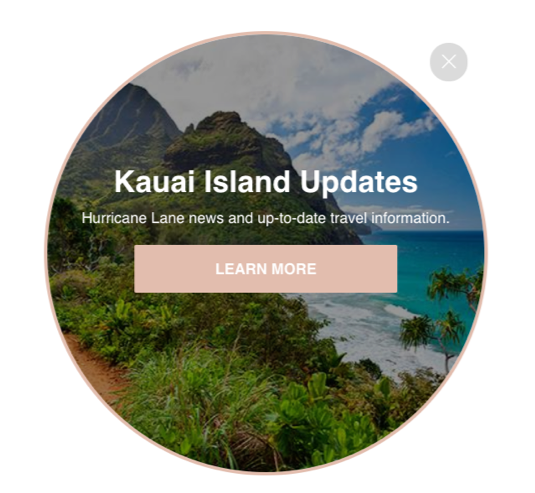 Layer encouraging users to read updates about a local hurricane
Layer encouraging users to read updates about a local hurricane
Unfortunately, in recent years, hurricanes and other extreme weather conditions appear to be on the increase, often creating significant stress for travelers and local businesses alike. Quite often in the case of bad weather, visitors can be deterred from booking through fear of personal danger and those who have already booked risk cancelling their reservation. It is therefore vital for hotels to incorporate up-to-date information into their websites to reassure users as soon as they arrive that the guests’ interests are the priority.
In the example above, you can see that Ko'a Kea Hotel & Resort in Hawaii informed its users of inclement weather conditions for the coming days. As a result, they helped users to stay engaged and reduced the bounce rate due to lack of information. They used a Layer to highlight the message on their homepage and included a call-to-action with a clickable link to find out more on a separate landing page providing detailed weather updates.
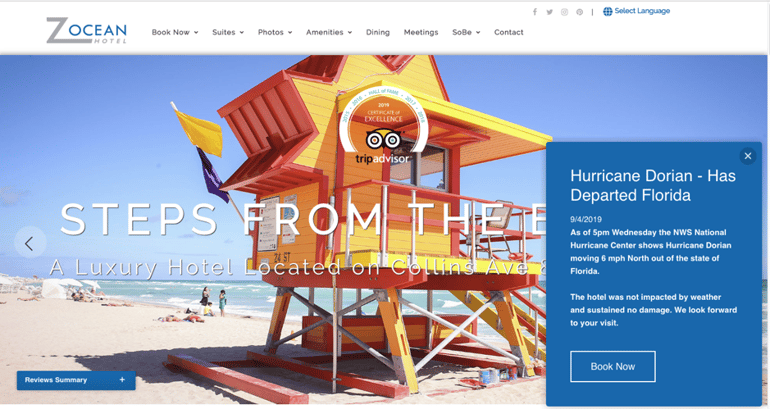 Layer reassuring users that the hurricane had departed
Layer reassuring users that the hurricane had departed
Once the storm is over, it is critical to make sure users are aware of this as soon as possible. In the above example, the Z Ocean hotel in Florida created a Layer in which they offered their website visitors up-to-date information about the passing hurricane. The Layer was updated every 12 hours which meant that the information was in current time and provided users with a continual feed of information, reassuring them that there was no longer any risk involved in traveling there.
Environmental issues
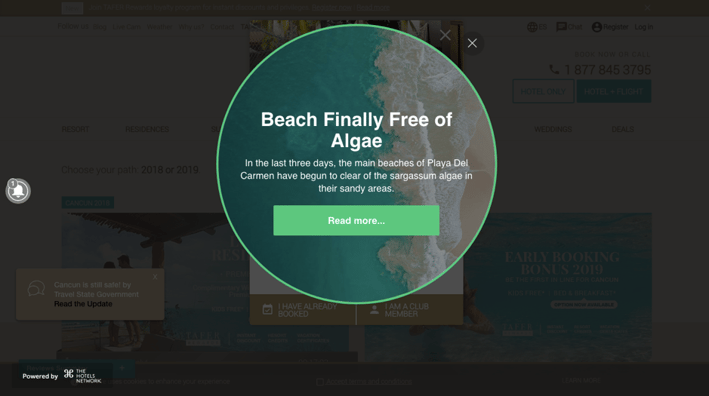 Layer informing users that the beach is free of algae
Layer informing users that the beach is free of algae
Word of mouth can spread very fast and when booking a beach destination, the last thing you want to be met with is a beach covered with algae. The immediate response would be a feeling of disregard towards the hotel for not communicating to you the presence of such an issue. That is why Tafer Hotels & Resorts kept their users informed about the status of the algae and as a result ensured that their guests felt like their needs were being catered for and prioritised over the needs of the business. Once the algae situations was resolved, the message was updated to reassure guests that there will be no further issues with the beach and this may just be the encouragement the guest needed to make a reservation. This transparency approach will translate into a more favourable attitude towards the hotel brand and may also potentially lead to increased guest satisfaction.
Relevant important hotel information
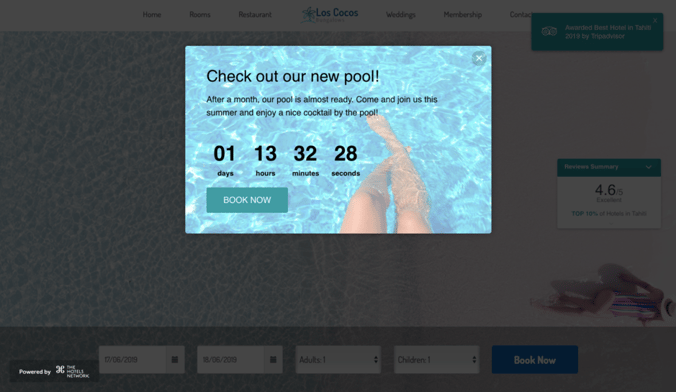 Layer updating users about the new pool opening
Layer updating users about the new pool opening
Aside from external incidents, there can also be internal events at the hotel, such as refurbishments, that can impact guests and therefore requires clear communication. Layers are again the ideal way to highlight important information on your website and ensure it is seen by visitors.
Here we can see an example of a hotel that has created a Layer to inform users of the reopening of their pool following refurbishment. It is useful for hoteliers to do this because in some cases guests can be significantly put off by construction or certain closures of facilities. Here the hotel is reassuring guests that works are now finished and inciting them to make a booking to try out their stunning new pool area.
Informing guests about on-going refurbishments is all about managing guest expectations and decreasing the risk of guest disappointment upon arrival. If there is a closure on your property or construction work of some sort it is also possible to update your website with recommendations for sister properties or other restaurant alternatives for example. Try to avoid negativity and always provide a solution when voicing a potential issue.
Above are just a small number of the many ways in which you could make your website more relevant and engaging, making sure you address any relevant current issues. Whatever the method, the goal remains the same, to make sure users see important messages, and at the right time, so as to reassure them and ultimately boost direct conversions. Read our full guide to discover other ways in which hotels are showcasing instant messaging on their website.






